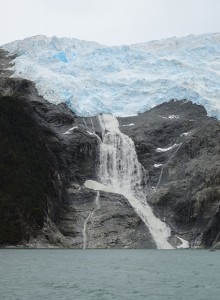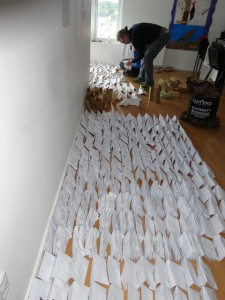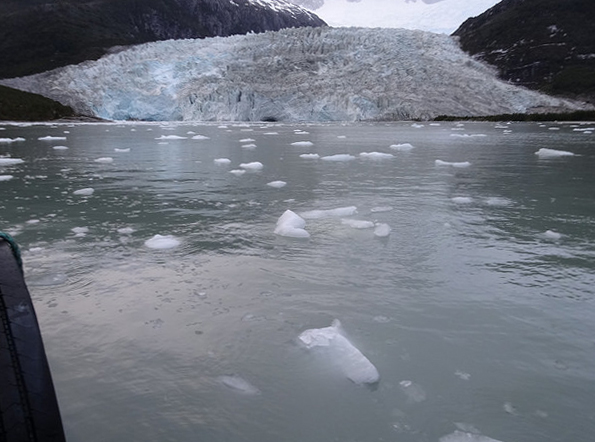From the Field: Bill Buck in Cape Horn 2014, Part 13
Posted in Travelogue on May 16, 2014 by Bill Buck
William R. Buck, Ph.D., is the Mary Flagler Cary Curator of Botany at The New York Botanical Garden. Every January for the last three years, Dr. Buck, a moss specialist, and a team of colleagues have journeyed to the Cape Horn region at the southern tip of South America to document the area’s rich diversity of mosses and search for new species.
January 27, 2014; in transit to Punta Arenas
 Time has lost meaning. We’re on the long trek back to Punta Arenas now, which is supposed to take about a day and a half. We arrived in Puerto Williams two nights ago (could it really have been only two nights ago?). We transferred ashore for one of those nights and stayed in the Universidad de Magallanes house. Our top priorities were hot showers and dealing with leftover specimens—in that order.
Time has lost meaning. We’re on the long trek back to Punta Arenas now, which is supposed to take about a day and a half. We arrived in Puerto Williams two nights ago (could it really have been only two nights ago?). We transferred ashore for one of those nights and stayed in the Universidad de Magallanes house. Our top priorities were hot showers and dealing with leftover specimens—in that order.
We went to dinner at the only restaurant in town that could handle a group of nine people. This was to be Rina Charlín’s last meal with us since she was staying behind in Puerto Williams. Fortunately, our prior arrangements were successful, and we surprised Matt von Konrat at the end of the meal with a cake for his 10th wedding anniversary. He seemed genuinely touched and took a photo of himself with the cake to send to his wife in Chicago.
After cake, Matt and Laura Briscoe hurried back to the university house for a late night of photographing oil-bodies, the distinctive, oil-filled structures found in the cells of most hepatics, or liverworts. It’s important to photograph them quickly because they disintegrate when the plant dries out. Matt and Laura didn’t get to bed until nearly 4 a.m. The final tally for the number of oil-bodies photographed this year is 140. This will be an amazing addition to a flora of a remote area of the world. I was also pleased to hear that one of the small hepatics I picked up proved interesting and unusual.
Matt and Laura were not the last to bed. Ernesto Davis and Juan Larraín had gone out to a party, with the former returning shortly after 5 a.m., alone. I asked about Juan, but Ernesto simply said, “I don’t know,” laughed, and fell asleep. Juan arrived around 7:30 a.m., indignant that Ernesto had abandoned him. I may once have been that young, but I was never that social!

That morning we loaded the gear in the van along with a few people, and the rest of us started walking down to the ship. It began to rain, and the van soon stopped so everyone could jump in. But once again, I felt a connection to the weather and let the van go without me. I idly interpreted the shower as Navarino crying over our final departure from the island. I assured her I could never forget her, and in short order the rain stopped.
By the time our gear was loaded onto the ship, the wind had picked up, leading the Chilean navy to close the port. Ships could dock, but they couldn’t leave. As rapidly as the skies had darkened, however, they cleared. We left before the navy could close the port again. The rough Beagle Channel made it clear why such measures were necessary in the first place.
From time to time, we reached a calm stretch of water, shortly after which it became rough again. In some ways, this foiled my plans for a glacier sightseeing trip because the sea was washing over the sides, preventing us from coming out on deck. But all was not lost. At 8 p.m. we came to Pia Glacier, which terminates in a small sound.
Surrounded by ice and rock on land and scores of small icebergs in the water, we had dinner with a phenomenal view. The waning light of evening colored the glaciers a pale turquoise. After the long night before, we all went to bed early. Calm waters, though, would not hold.
At 5 a.m., I was awakened by the ship rocking violently from side to side. Sounds of items banging around the ship echoed down the hallway to the bunkroom. Doors slammed on their frames, and people were tossed from their bunks. It was like a carnival ride run amok. We were later told that the culprit was a rough stretch of water across Bahía Desolata, a region with no protective land between itself and Antarctica.

The sea had calmed by 6 a.m., and I ventured from my bunk. I found John Brinda and his trusty bucket in the galley, as expected, but it caught me off guard that one of the crew, Chopo, was suffering in kind. In the short time I was out on deck, the calm ended, and I dodged waves to get back inside.
The day alternated between rough and calm seas, with most of us retreating to our bunks when the waves grew violent. Meals were timed for the calms in between. I’ve now been told that we should arrive in Punta Arenas at 1 a.m. and sleep until morning.
Because of the awkward timing, I started collecting money from our group to tip the crew. These trips would never have been so successful or enjoyable had the crew not been so good-natured and helpful. Regardless of which ship we’ve been on, these sailors have always been patient with our odd ways and poor (or absent) Spanish, and none of them ever hesitated to offer a hand at a moment’s notice. They are the unsung heroes of these expeditions.
Past Expedition Entries:
Photos provided by Barbara Andreas.

